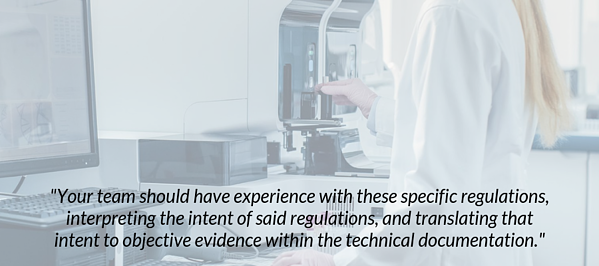As the May 26, 2022 deadline has come and gone, now it is more critical than ever to evaluate what your organization needs to accomplish. If this feels like a daunting task, you’re not alone, as many organizations are facing the same challenges. The differences between the IVDR and IVDD are myriad and complex, and for those who are not thoroughly educated on these regulations, some components may be overlooked. This is why it’s vital to consider the following when embarking on your IVDR project, and creating the right team that will support your regulatory and compliance needs.
Considerations to Keep in Mind
Before any IVDR initiative has begun, organizations should first evaluate their current staff and resources. Consider the background of your existing team and whether they have the right experience, skills, and capabilities. Understanding and interpreting the regulations correctly is important, and having a deep awareness of the changes involved is vital to ensure that compliance is achieved. The regulations that IVDR is introducing are detailed and risk-based, as opposed to their IVDD counterparts. Therefore, your team should have experience with these specific regulations, interpreting the intent of said regulations, and translating that intent to objective evidence within the technical documentation. Your team should have experience working with Notified Bodies and other regulators so that they have the relevant knowledge required when dealing with their designated Notified Body while also qualifying products.

More specifically, your team should have experience working with regulations specific to the particular product you are producing. Your device should be classified as either a medical device, combination product, or IVD. If, for example, someone has experience working with blood glucose monitors to ensure their compliance, that may not reflect the same aspects as another diagnostic device. Putting together the right team involves recruiting individuals who understand the product family you are working with.
In addition, your team should comprehend the current state of any existing documentation and Quality Management System (QMS). Completing a gap assessment will help you understand the scope of the project in regards to what is needed to reach IVDR compliance. Once the gap assessment is complete, create a remediation plan to ensure that nothing is overlooked. This remediation plan should outline all related timelines, the project budget, and how many individuals you will need to support you throughout the course of this compliance initiative.
Identification of Team Leader
Once your gap assessment is completed and you have a thorough understanding of the scope of your initiative, it’s crucial to identify a team leader, whether that is an individual or a committee. The person or committee can be designated internally or externally, but as IVDR is so complex, it is vital to identify an individual or individuals who are in charge of maintaining compliance within the organization, both at the beginning of the project and in the long-term. The unique needs of your business may vary depending on the complexity of the product line with which you are trying to ensure compliance. Having a leader with a deep understanding of IVDR and the objectives of your organization will help ensure compliance is achieved.
Finding the Right Talent
When searching for the right individuals to augment your IVDR team, the following roles and related keywords will lead you to those who can provide the assistance you need.
- IVDR Assessor
- European In Vitro Diagnostic Regulation Consultant
- IVDR Regulatory Compliance Support
- Regulatory Affairs Specialist
- Compliance Specialist
- Risk Assessor
- Risk Manager
- Compliance Manager
In addition, the following certifications and qualifications are applicable when searching for talent within the IVDR space:
- ISO 13485 2016
- ISO 14971 Risk Management
- IVDD
- IVDR
It is worth keeping in mind that since IVDR is relatively new, it’s likely that those with this unique experience will be in high demand, and somewhat difficult to find. It’s also helpful to note that they might not have updated their resumes yet, so if they have experience with IVDD, it might be worthwhile to contact them and identify their experience with IVDR.
Long-Term Needs
Once an IVDR product is compliant, remember that things are constantly evolving. Treat IVDR compliance as an ongoing process — consider all the components of your QMS, technical documentation, and other aspects of the business as things that need constant attention. Complete regular post market surveillance, and keep an eye on how clients and customers react to these devices once compliant and available for use. If you maintain this vigilant stance, your organization will be able to ensure that future needs are not overlooked.
IVDR compliance is a multi-layered, complex, and often challenging project to embark on. With the right processes, resources, expert support, and holistic approach, your organization will achieve success and maintain a place in the competitive, ever-changing market.
If you are looking for support with an IVDR project, click here to learn more.

.svg.png)

